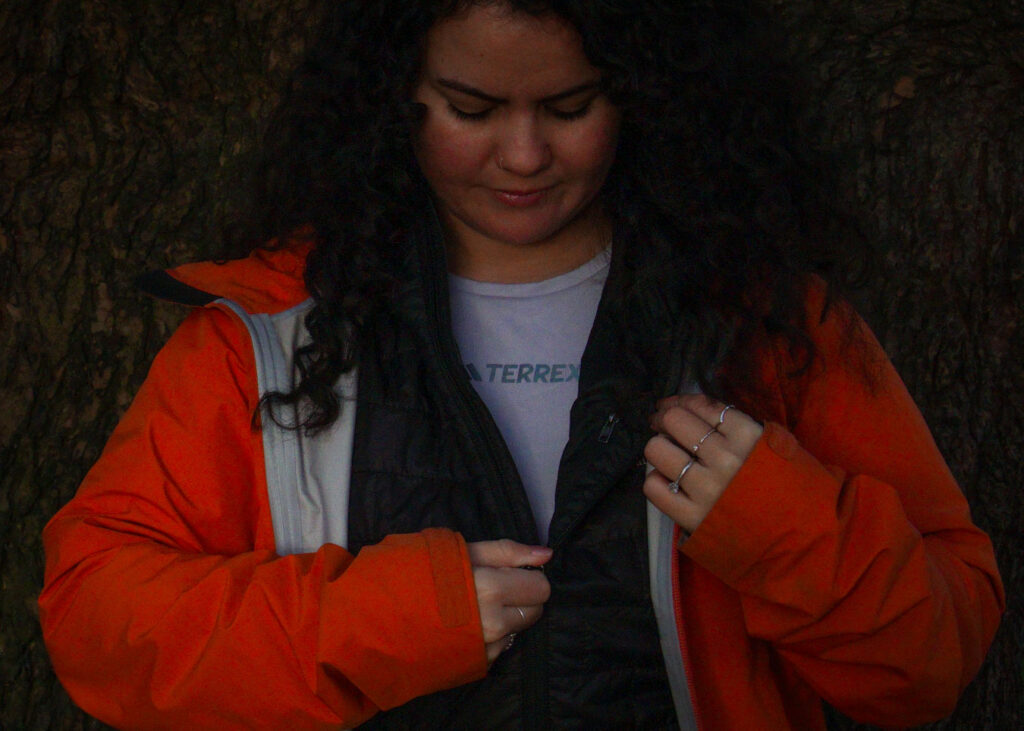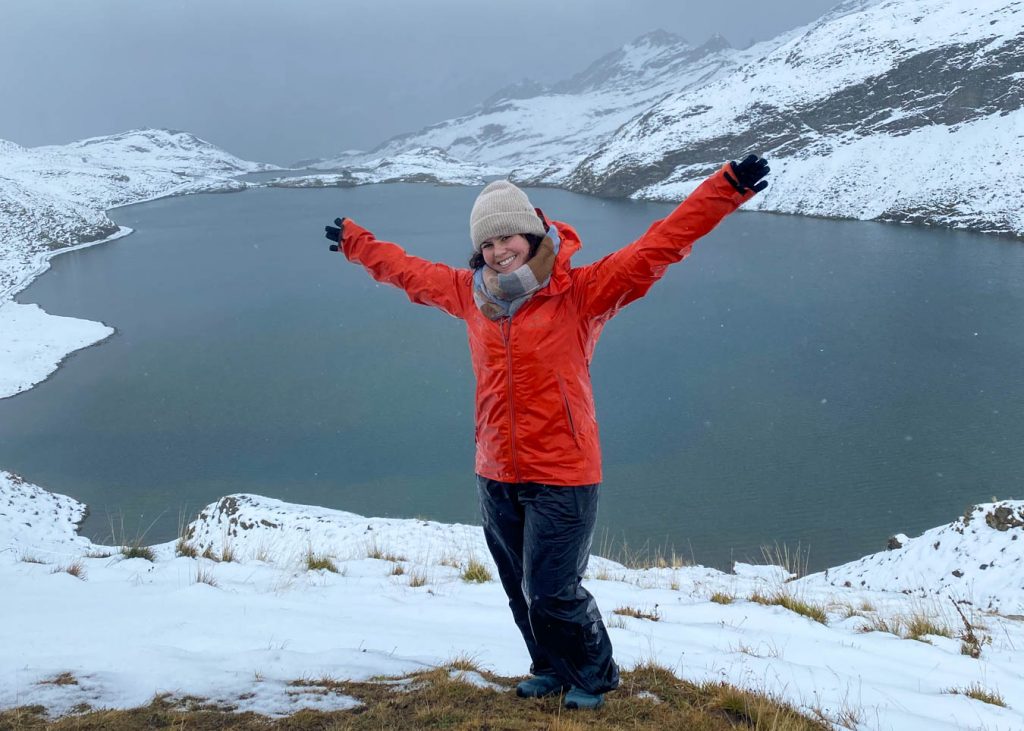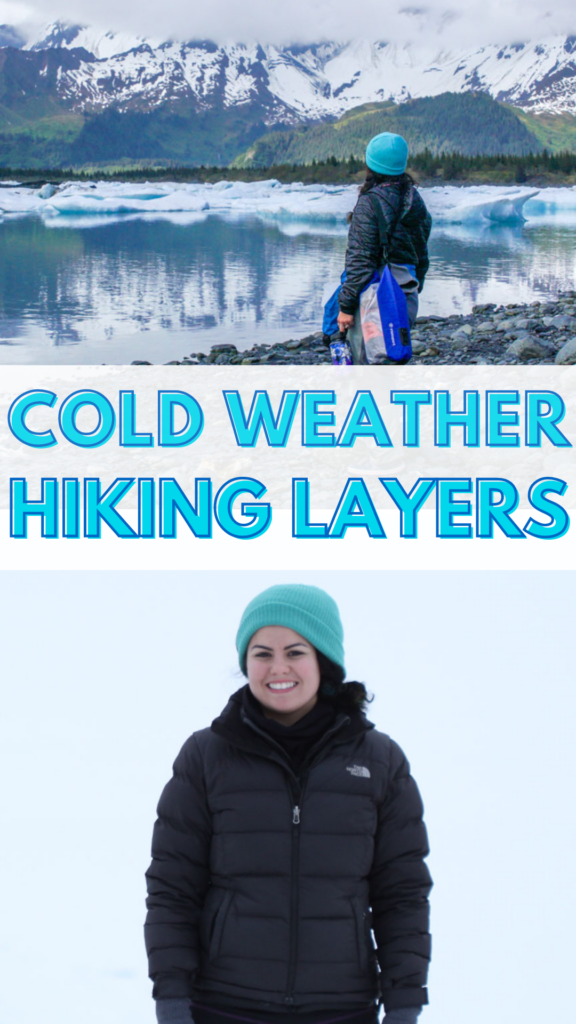Understanding how to layer your clothing is key to enjoying outdoor activities, but choosing the right layers for hiking isn’t just about throwing on a bunch of clothes.
You want to make sure you wear effective layers in order to stay warm, dry, and comfortable in various weather.
Over time, I’ve been able to master the skill of layering and ensure I’m dressed properly for hiking in Alaska and even climates around the world.
However, selecting hiking layers involves considering factors like layer type, materials, and weather conditions.
In this post, I’ll guide you through the basics of layering and how to use a layering system to choose the best layers for hiking.
AndreaKuuipoAbroad.com is a member of the adidas Blogger Community. This article features gifted products. Read more about my Affiliate Disclosure.
Understanding the Layering System
Whenever you venture outdoors, especially on longer hikes or in varying weather conditions, understanding how to layer clothing effectively is so important.
The main purpose of using layers is to be able to put layers on or remove them based on your activity level, body temperature, and weather.
There are three essential layers to know: the base layer, mid or insulation layer, and outer layer.
These layers form the foundation of an efficient layering system, also referred to as the three-layer system.
All layers of clothing have their own function and it’s important to understand each one in order to learn how to layer your clothes for hiking.
1. Base Layer: Moisture Wicking
The base layer is the first layer that you put on. It’s the closest layer to your skin, which means it’s the first layer to protect you against the elements.
The purpose of the base layer is to wick away moisture by moving sweat away from your skin.
2. Mid Layer: Retains Heat
The mid layer, often referred to as the insulation layer, is the second layer that you wear on top of the base layer.
The purpose of this middle layer is to trap body heat to keep you warm.
This layer includes a variety of options such as a fleece pullover, down jacket, or synthetic insulated jacket.
The more efficiently this layer traps that heat, the warmer you’ll be.
3. Outer Layer: Wind and Rain Protection
The outer layer, often referred to as the shell layer, is the third layer to put on after the base layer and mid layer.
The purpose of the outermost layer is to act as a barrier against external elements like heavy rain, strong winds, and snow.
Ideal outer layers are usually made of waterproof or water-resistant materials, or they have a special finish (called DWR) that makes water slide off the fabric.
The most important thing about this final layer is that it is actually waterproof in order to stop moisture from soaking through and making your other clothes wet.
Wet clothes can make you feel uncomfortable and can easily become dangerous, especially when it’s cold and wet outside.

Choosing the Right Layers For Hiking
Selecting the Base Layer
When it comes to choosing a base layer for hiking, you’ll want to take a closer look at the material it’s made out of and how warm it is.
Base Layer Materials
When selecting a base layer to wear, prioritize moisture-wicking fabrics, such as merino wool or synthetic materials like polyester or nylon blends.
These fabrics effectively wick moisture away from the skin to keep you dry and regulate your body temperature, especially during strenuous hikes.
Here are the most common natural and synthetic materials you’ll find in base layers:
- Merino wool
- Silk
- Polyester
- Nylon
- Cotton
Keep in mind that wearing cotton clothing is not a good choice (unless hiking in a hot and dry climate or dry conditions) because it takes forever to dry and doesn’t keep you warm when it’s wet.
Besides cotton, there are subtle differences in wicking and drying for each material, and in odor retention and durability.
Most hikers end up wearing their preferred fabric, whether it’s a merino wool base layer or synthetic base layers.
Base Layer Weights
Base layers come in various weights: lightweight, midweight, and heavyweight. Essentially, heavier and thicker fabrics will keep you warmer.
The choice of base layer weight depends on various factors including the weather, activity level, and personal preferences.
- Lightweight Base Layers: A thin base layer that has excellent moisture-wicking properties and breathability. They are comfortable, quick-drying, and provide a basic level of insulation without adding bulk, making them a great choice for hiking in warmer climates or during strenuous hikes.
- Midweight Base Layers: Offer a balance between warmth and breathability, they are versatile and suitable for a wide range of conditions. They provide moderate insulation while still managing moisture effectively, making them a great choice for hiking in moderately cold temperatures and environments and variable weather conditions.
- Heavyweight Base Layers: Designed for extreme cold conditions to offer maximum insulation and warmth. They are made from thicker materials to retain the most heat and provide a high level of warmth in frigid temperatures. Heavyweight base layers are perfect for winter hiking, especially in cold climates like Alaska.
Short vs Long
Base layers come in short and long options: short-sleeved shirts and long-sleeved shirts to keep your upper body warm and short underwear and long underwear, long johns, or tights to keep your lower body warm.
For high-intensity hikes or hiking in warm weather, thin, short-sleeve base layers usually work best. Some base layers also provide sun protection.
However, if you would rather keep your skin dry from dripping sweat, you may prefer to wear long-sleeve layers in warmer climates.
For low-intensity hikes or hiking in cold conditions, heavier, long-sleeve base layers work best.
You still want to prioritize unrestricted movement. Choosing thinner base layers and a mid-layer instead of thick, insulated base layers will allow for comfort without added bulk.

Selecting the Mid Layer
When choosing a mid-layer for hiking, you’ll want to take a closer look at the type of insulation, warmth, and packability.
This layer is crucial, especially in colder environments or during winter hikes, where maintaining a comfortable body temperature is essential for your safety and enjoyment.
Types of Insulating Layers
The Insulating layer breaks down into natural insulation or synthetic insulation, such as down, synthetic, and fleece.
You’ll find various styles and designs tailored for different outdoor activities and conditions. Some have additional features like hoods, adjustable cuffs, or pockets for added functionality.
Personally, I’m either wearing a down puffy jacket or a fleece pullover as an insulation layer while I’m hiking, depending on what other layers I have on.
- Down Insulation: Down insulation, found in puffy jackets, offers exceptional warmth without excessive bulk due to its high warmth-to-weight ratio. Its loft traps heat in air pockets and allows compression for easy packing. However, it may lose insulation when wet, unless treated with DWR or protected by a waterproof layer. Down insulation is often categorized by its fill power and a higher fill power indicates better insulation.
- Synthetic Insulation: Synthetic insulation, typically made from polyester fibers, often has a lower warmth-to-weight ratio compared to down. However, it excels in maintaining warmth even when wet and dries faster than down, so it’s a great option for hiking in wet or humid environments. Synthetic material can also retain its insulating properties even after repeated compression and washing. Its lack of compressibility can result in bulkiness when packed.
- Fleece Insulation: Fleece is made from polyester fibers or a blend of polyester and other synthetic fibers. It has a great warmth-to-weight ratio and comes in different thicknesses for varying degrees of warmth. It’s breathable, lightweight, quick drying, moisture-wicking, and durable. It’s soft and comfortable, making it an ideal layer for milder hiking conditions. While it can fit well under outer layers without adding bulk, its lack of compressibility makes it slightly bulky to pack.
5 Factors to Consider
- Warmth-to-Weight Ratio: Refers to the efficiency of insulation materials in providing warmth relative to their weight. This ratio is particularly crucial in outdoor gear, where warmth is essential, but reducing bulk and weight is desirable. Materials with a high warmth-to-weight ratio, like high-quality down insulation, effectively retain body heat while being lightweight and less bulky.
- Moisture Management: Assess the expected weather conditions. If it’s likely to rain or be damp, synthetic insulation might be a more practical choice due to its ability to retain warmth when wet.
- Packability and Compressibility: When space is limited on a longer day hike or backpacking trip, the ability to compress your insulating layer into a smaller size can be beneficial. Down jackets have excellent compressibility and are often the top choice for this reason.
- Layering Compatibility: Your insulating layer should fit comfortably under your outer shell without being too restrictive to allow for ease of movement. Some hikers choose to wear a puffy jacket as their outermost layer instead of underneath another jacket in order to prevent compression of the insulation and preserve its insulating properties.
- Activity Level and Conditions: Your choice of insulation might vary based on the intensity of your activity and the temperatures you anticipate. For strenuous hikes, you may choose to wear a lightweight fleece or micro-down jacket to prevent overheating.

Selecting the Outer Layer
When choosing an outer layer for hiking, you’ll want to take a closer look at its weather resistance and breathability.
Types of Outer Layers
The outer layer is the final layer in the three-layer system. There are two types of outer layers, often called shells: hard shell and soft shell.
Shell layers are essential for protecting you from wind and rain, keeping you dry and warm while hiking in windy and wet conditions.
- Hard Shell Jackets: Designed to trap more warmth and provide protection against harsh weather conditions like heavy rain, strong winds, and snow. These rain jackets are typically made from fully windproof and waterproof materials like Gore-Tex to ensure water resistance while remaining breathable. They usually feature sealed seams, waterproof zippers, and adjustable hoods, cuffs, and hemlines to prevent water from seeping in.
- Soft Shell Jackets: Soft shells are less waterproof than hard shell jackets because they are constructed from soft, stretchy, and often water-resistant synthetic materials, like polyester, elastane, or nylon. This gives them better breathability and flexibility than hard shells, allowing for greater mobility. Soft shells are best for hiking in light rain, wind, or where breathability is crucial. It’s not a good idea to wear them in severe weather conditions otherwise you’ll be soaked.
- Rain Pants and Shell Pants: A rain pant or shell pant is made from waterproof or water-resistant materials, keeping your lower body dry by repelling water and preventing it from soaking through the fabric. By keeping your lower body dry, they also help retain body heat. These pants typically feature sealed seams, adjustable waistbands, and zippered ventilation for improved breathability. It’s recommended to match them to your shell jacket type, whether it’s a hard shell or a soft shell.
3 Factors to Consider
- Weather Resistance: Wearing a waterproof and windproof outer layer ensures you stay dry and comfortable throughout your hike, even in bad weather. In very wet and warm climates, where even a breathable soft-shell jacket might be too hot or become soaked, you can swap out the shell jacket and pants for a poncho or umbrella.
- Durability and Weight: Choose to wear materials that offer a balance between durability and weight to avoid feeling weighed down during your hike. Some designs offer versatility by being lightweight and easily packable, making them convenient to carry on hikes.
- Ventilation: Many outer shell layers have ventilation features, such as pit zips or mesh-lined pockets, that aid in managing body heat and moisture. These options allow for increased airflow, preventing overheating during strenuous hikes.

Layering Strategies for Various Conditions
When it comes to choosing your layering strategy, you’ll quickly find there are many clothing combinations for each layer.
The most important part is to choose a layer combination that makes sense for the type of hike, current and forecasted weather conditions, and your own personal budget.
As the weather conditions change throughout your hike, you want to be able to add or remove layers. Too cold? Wear an insulation layer. Rain stopped? Take off your outer shell.
Below, you’ll see a few layering outfits for hiking in warm weather, cold weather, and wet weather.
Warm Weather Hiking
Hiking outfit for warm weather:
- Short-sleeve merino wool t-shirt
- Nylon shorts
- Lightweight wind jacket
- Hiking sandals
- Wide-brim hat
Cold Weather Hiking
Hiking outfit for cold weather:
- Midweight merino wool tights
- Midweight merino wool long-sleeve baselayer
- Down jacket
- Hard shell pants
- Midweight merino wool socks
- Insulated hiking boots
- Fleece neck warmer
- Wool mittens
- Beanie
Wet Weather Hiking
Hiking outfit for wet weather:
- Short-sleeve synthetic t-shirt
- Lightweight polyester tights
- Lightweight fleece jacket
- Waterproof rain jacket
- Waterproof rain pants
- Lightweight waterproof gloves
- Waterproof hiking boots
- Ball cap

Tips for Effective Layering
Mastering the art of layering clothing for hiking is essential for an enjoyable and safe outdoor experience. The layering system is a versatile way to adjust to diverse weather conditions and levels of activity.
- Activity Level and Adjustment: Adjust layers according to your activity level. Shed outer layers to prevent overheating as your body generates more heat.
- Testing Your Layers: Before going on longer mountain hikes or backpacking trips, ensure that your layers effectively manage moisture and keep you comfortable for a long time.
- Weather Conditions: Match your layers with the weather conditions. Consider bringing extra layers such as a warm hat, neck gaiter, or face mask for added insulation in colder weather. In warmer climates or during summer hikes, thinner layers and breathable fabrics are a better choice. In heavy rain, don’t forget rain pants to keep your lower body dry.
- Avoiding Common Mistakes: Cotton clothing should be avoided in colder and wetter conditions. Wearing wet cotton can lead to a drop in body temperature, posing a risk of hypothermia.
- Functionality: Prioritize functionality and compatibility among layers to ensure maximum mobility and comfort.
- Material Choice: Consider synthetic fabrics, merino wool, down, and fleece for their moisture-wicking, insulating, and weather-resistant properties.
Implementing effective layering strategies with the right materials allows you to effectively manage body temperature, moisture, and comfort, ensuring you stay dry, warm, and protected while in diverse conditions.

Do you have any questions about clothing layering for hiking? Leave them in the comments.

More Hiking Clothing Posts
4 Best Types of Hiking Shoes to Wear
What to Wear Hiking in Alaska Winter
What to Wear Hiking in Alaska (Summer)
Pin This Post For Later
Want to remember how to layer for hiking? Share it on Pinterest for later!




